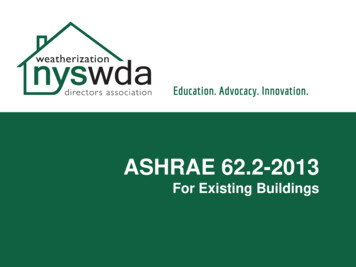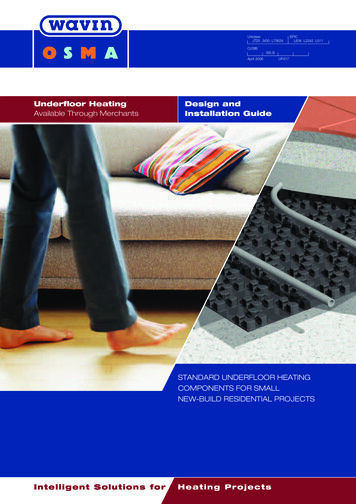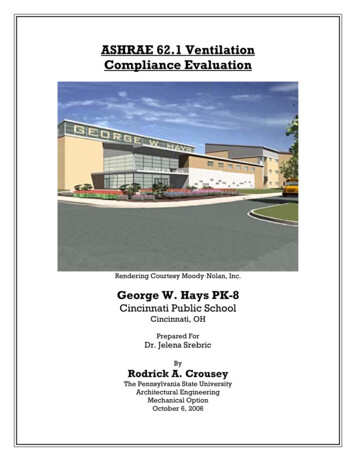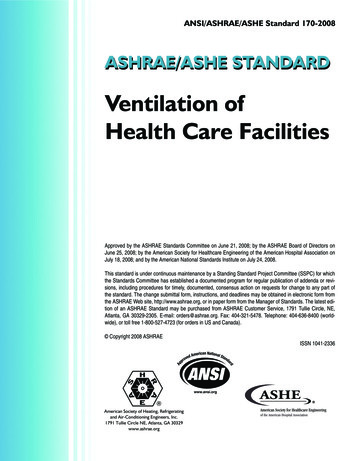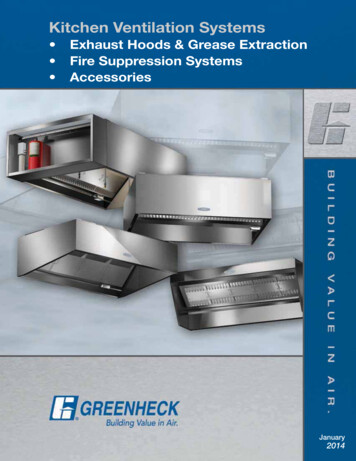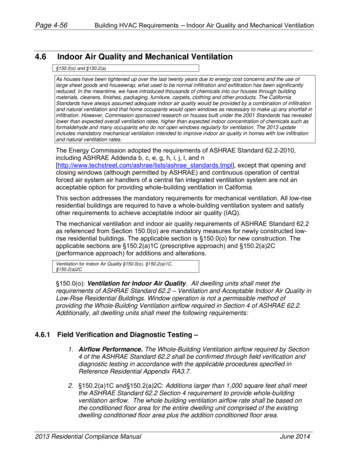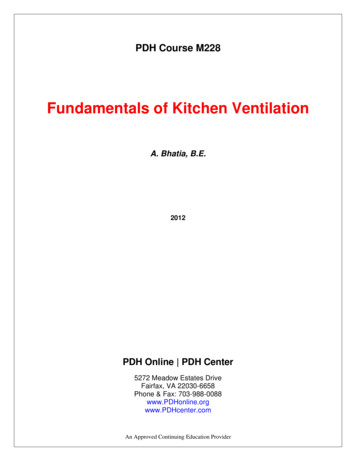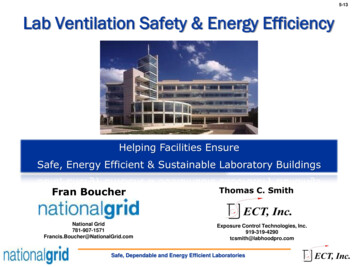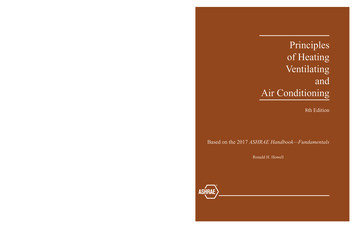
Transcription
It is suitable both as a textbook and as a reference book for undergraduate engineering courses inthe field of air conditioning, heating, and ventilation; for similar courses at technical and vocationalschools; for continuing education and refresher short courses for engineers; and for adult educationcourses for professionals other than engineers, especially when combined with ASHRAE Handbook—Fundamentals.The material is divided into three major sections: general concepts, Chapters 1–10; air-conditioningsystems, Chapters 11–16; and HVAC&R equipment, Chapters 17–20. There are several significantchanges in this revised edition. Chapter 4 has new values for climatic design information. Chapter 7has been extensively revised with new design data. In addition, the chapters on system design andequipment have been significantly revised to reflect recent changes and concepts in modern heatingand air-conditioning system practices.This book includes access to a website containing the Radiant Time Series (RTS) Method LoadCalculation Spreadsheets, which are intended as an educational tool both for the student and forthe experienced engineer wishing to explore the RTS method. These spreadsheets allow the user toperform RTS cooling load calculations for lights, people, equipment, walls/roofs, and fenestrationcomponents using design day weather profiles for any month. Cooling and heating loads can becalculated for individual rooms or block load zones. Twelve-month cooling calculations can be doneto determine the month and time of peak cooling load for each room or block load zone. In addition,room/zone worksheets can be copied and modified within the spreadsheet to analyze as many roomsor zones as desired; the number of rooms/zones is limited only by the available computer memory.Principles of HVACPrinciples of Heating, Ventilating, and Air Conditioning is a textbook based on the 2017 ASHRAEHandbook—Fundamentals. It contains the most current ASHRAE procedures and definitive, yeteasy to understand, treatment of building HVAC systems, from basic principles through design andoperation.Principlesof HeatingVentilatingandAir Conditioning8th Edition8th EditionBased on the 2017 ASHRAE Handbook—FundamentalsRonald H. HowellISBN: 978-1-939200-73-0 (hardback)978-1-939200-74-7 (PDF)ASHRAE1791 Tullie CircleAtlanta, GA 30329-2305404-636-8400 (worldwide)www.ashrae.orgPHVAC TEXT cover.indd 1ProductCode:20073090567 7/1797819397/12/2017 12:01:20 PM
PRINCIPLESOF HEATINGVENTILATINGANDAIR CONDITIONING
ABOUT THE AUTHORSRonald H. Howell, PhD, PE, Fellow ASHRAE, retired as professor and chair of mechanical engineering at the University of South Florida and is also professor emeritus of the University of Missouri-Rolla. For 45 years he taught coursesin refrigeration, heating and air conditioning, thermal analysis, and related areas. He has been the principal or co-principal investigator of 12 ASHRAE-funded research projects. His industrial and consulting engineering experience rangesfrom ventilation and condensation problems to the development and implementation of a complete air curtain testprogram.The following authors contributed significantly to the textbook Principles of Heating, Ventilation, and Air Conditioning.They recently passed away and were not part of the 2017 revisions.William J. Coad, PE, Fellow ASHRAE, was ASHRAE president in 2001-2002. He was employed with McClure Engineering Associates, St. Louis, Mo., for 45 years. He was also president of Coad Engineering Enterprises. He served asa consultant to the Missouri state government and was a lecturer in mechanical engineering for 12 years and an affiliateprofessor in the graduate program for 17 years at Washington University, St. Louis. He was the author of Energy Engineering and Management for Building Systems (Van Nostrand Reinhold). Mr. Coad passed away in August 2014.Harry J. Sauer, Jr., PhD, PE, Fellow ASHRAE, was a professor of mechanical and aerospace engineering at the University of Missouri-Rolla. He taught courses in air conditioning, refrigeration, environmental quality analysis and control,and related areas. His research ranged from experimental boiling/condensing heat transfer and energy recovery equipment for HVAC systems to computer simulations of building energy use and actual monitoring of residential energy use.He served as an advisor to the Missouri state government and has conducted energy auditor training programs for theUS Department of Energy. Dr. Sauer passed away in June 2008.
PRINCIPLESOF HEATINGVENTILATINGANDAIR CONDITIONING8th EditionA Textbook with Design Data Based on the2017 ASHRAE Handbook—FundamentalsRonald H. HowellAtlanta
ISBN 978-1-939200-73-0 (hardback)978-1-939200-74-7 (PDF) 1990, 1994, 1998, 2001, 2005, 2009, 2013, 2017 ASHRAE1791 Tullie Circle, N.E.Atlanta, GA 30329www.ashrae.orgAll rights reserved.Printed in the United States of AmericaASHRAE is a registered trademark in the U.S. Patent and Trademark Office, owned by the American Society of Heating, Refrigerating and Air-Conditioning Engineers, Inc.ASHRAE has compiled this publication with care, but ASHRAE has not investigated, and ASHRAE expressly disclaims any dutyto investigate, any product, service, process, procedure, design, or the like that may be described herein. The appearance of anytechnical data or editorial material in this publication does not constitute endorsement, warranty, or guaranty by ASHRAE of anyproduct, service, process, procedure, design, or the like. ASHRAE does not warrant that the information in the publication is freeof errors, and ASHRAE does not necessarily agree with any statement or opinion in this publication. The entire risk of the use ofany information in this publication is assumed by the user.No part of this publication may be reproduced without permission in writing from ASHRAE, except by a reviewer who may quotebrief passages or reproduce illustrations in a review with appropriate credit, nor may any part of this publication be reproduced,stored in a retrieval system, or transmitted in any way or by any means—electronic, photocopying, recording, or other—withoutpermission in writing from ASHRAE. Requests for permission should be submitted at www.ashrae.org/permissions.Names: Howell, Ronald H. (Ronald Hunter), 1935- author.Title: Principles of heating ventilating and air conditioning : a textbookwith design data based on the 2017 ashrae handbook of fundamentals /Ronald H. Howell.Description: 8th edition. Atlanta : ASHRAE, [2017] Includesbibliographical references and index.Identifiers: LCCN 2017033377 ISBN 9781939200730 (hardcover : alk. paper) ISBN 9781939200747 (pdf)Subjects: LCSH: Heating--Textbooks. Ventilation--Textbooks. Airconditioning--Textbooks.Classification: LCC TH7012 .H73 2017 DDC 697--dc23 LC record available at https://lccn.loc.gov/2017033377ASHRAE STAFF SPECIAL PUBLICATIONSMark S. Owen, Editor/Group Manager of Handbook and Special PublicationsCindy Sheffield Michaels, Managing EditorJames Madison Walker, Managing Editor of StandardsLauren Ramsdell, Assistant EditorMary Bolton, Editorial AssistantMichshell Phillips, Editorial CoordinatorPUBLISHING SERVICESDavid Soltis, Group Manager of Publishing ServicesJayne Jackson, Publication Traffic AdministratorPUBLISHERW. Stephen ComstockUpdates and errata for this publication will be posted on theASHRAE website at www.ashrae.org/publicationupdates.
CONTENTSPart IGeneral ConceptsChapter 1BackgroundIntroduction. 1Historical Notes . 2Building Energy Use. 5Conceptualizing an HVAC System . 7Sustainability and Green Buildings . 7Problems . 8Bibliography . 9Chapter 2Thermodynamics and PsychrometricsFundamental Concepts and Principles. 11Properties of a Substance . 13Forms of Energy . 36First Law of Thermodynamics. 40Second Law of Thermodynamics . 42Third Law of Thermodynamics . 44Basic Equations of Thermodynamics . 44Thermodynamics Applied to Refrigeration . 44Applying Thermodynamics to Heat Pumps. 49Absorption Refrigeration Cycle. 49Problems . 50Bibliography . 55SI Tables and Figures. 55Chapter 3Basic HVAC System CalculationsApplying Thermodynamics to HVAC Processes . 67Single-Path Systems . 72Air-Volume Equations for Single-Path Systems . 72Psychrometric Representation of Single-Path Systems . 74Sensible Heat Factor (Sensible Heat Ratio). 74Problems . 76Bibliography . 80Chapter 4Design ConditionsIndoor Design Conditions . 81Outdoor Design Conditions: Weather Data . 88Other Factors Affecting Design . 140Temperatures in Adjacent Unconditioned Spaces . 140Problems . 141Bibliography . 142SI Tables and Figures. 143Chapter 5Load Estimating FundamentalsGeneral Considerations. 145Outdoor Air Load Components . 145Heat-Transfer Coefficients. 156Calculating Surface Temperatures. 170Problems . 171
ContentsviBibliography . 177SI Figures and Tables. 179Chapter 6Residential Cooling and Heating Load CalculationsBackground . 191General Guidelines. 192Cooling Load Methodology. 197Heating Load Methodology . 200Nomenclature. 205Load Calculation Example. 207Problems . 209Bibliography . 212SI Figures and Tables. 214Chapter 7Nonresidential Cooling and Heating Load CalculationsPrinciples. 221Initial Design Considerations. 225Heat Gain Calculation Concepts. 225Description of Radiant Time Series (RTS). 252Cooling Load Calculation Using RTS . 255Heating Load Calculations. 258Design Loads Calculation Example. 262Problems . 274Bibliography . 276SI Figures and Tables. 281Chapter 8Energy Estimating MethodsGeneral Considerations. 297Component Modeling and Loads. 298Overall Modeling Strategies . 299Integration of System Models. 300Degree-Day Methods . 301Bin Method (Heating and Cooling) . 310Problems . 312Bibliography . 316Chapter 9Duct and Pipe SizingDuct Systems . 317Fans . 354Air-Diffusing Equipment . 362Pipe, Tube, and Fittings . 364Pumps. 369Problems . 371References. 375SI Figures and Tables. 377Chapter 10Economic Analyses and Life-Cycle CostsIntroduction. 381Owning Costs. 381Service Life. 381Depreciation. 384Interest or Discount Rate . 384Periodic Costs . 384Operating Costs. 385
viiPrinciples of HVAC, 8th EditionEconomic Analysis Techniques. 389Reference Equations . 392Problems . 392Symbols . 393References. 394Bibliography . 394Part IIHVAC SystemsChapter 11Air-Conditioning System ConceptsSystem Objectives and Categories. 397System Selection and Design. 398Design Parameters . 398Performance Requirements. 399Focusing on System Options . 399Narrowing the Choice . 400Energy Considerations of Air Systems . 401Basic Central Air-Conditioning and Distribution System . 402Smoke Management. 404Components . 404Air Distribution. 407Space Heating . 409Primary Systems . 409Space Requirements. 411Problems . 414Bibliography . 416Chapter 12System ConfigurationsIntroduction. 417Selecting the System . 418Multiple-Zone Control Systems. 418Ventilation and Dedicated Outdoor Air Systems (DOAS) . 421All-Air System with DOAS Unit. 422Air-and-Water Systems with DOAS Unit. 422In-Space Temperature Control Systems . 423Chilled-Beam Systems. 425Problems . 429Bibliography . 432Chapter 13Hydronic Heating and Cooling System DesignIntroduction. 433Closed Water Systems . 434Design Considerations . 442Design Procedures . 451Problems . 453Bibliography . 454Chapter 14Unitary and Room Air ConditionersUnitary Air Conditioners . 455Combined Unitary and Dedicated Outdoor Air Systems. 457Window Air Conditioners. 457Through-the-Wall Conditioner System. 458Typical Performance. 459Minisplits, Multisplits, and Variable-Refrigerant-Flow (VRF) Systems. 459
ContentsviiiWater-Source Heat Pumps. 460Problems . 461Bibliography . 461Chapter 15Panel Heating and Cooling SystemsGeneral. 463Types. 464Design Steps. 466Problems . 467Bibliography . 467Chapter 16Heat Pump, Cogeneration, and Heat Recovery SystemsGeneral. 469Types of Heat Pumps . 469Heat Sources and Sinks. 471Cogeneration . 474Heat Recovery Terminology and Concepts . 475Heat Recovery Systems . 477Problems . 480Bibliography . 480SI Figures . 481Part IIIHVAC EquipmentChapter 17Air-Processing EquipmentAir-Handling Equipment . 483Cooling Coils . 483Heating Coils . 488Evaporative Air-Cooling Equipment . 489Air Washers . 490Dehumidification . 490Humidification . 492Sprayed Coil Humidifiers/Dehumidifiers . 494Air Cleaners . 494Air-to-Air Energy Recovery Equipment. 499Economizers. 506Problems . 507Bibliography . 508SI Table. 509Chapter 18Refrigeration EquipmentMechanical Vapor Compression. 511Absorption Air-Conditioning and Refrigeration Equipment . 529Cooling Towers. 536Problems . 537Bibliography . 539SI Tables . 540Chapter 19Heating EquipmentFuels and Combustion . 543Burners. 546Residential Furnaces . 547Commercial Furnaces . 549Boilers . 552
ixPrinciples of HVAC, 8th EditionTerminal Units . 554Electric Heating . 555Problems . 557Bibliography . 558Chapter 20Heat Exchange EquipmentModes of Heat Transfer . 561Heat Exchangers . 567Basic Heat Exchanger Design Equation . 569Estimation of Heat Load . 569Mean Temperature Difference. 569Estimation of the Overall Heat Transfer Coefficient U . 570Extended Surfaces, Fin Efficiency, and Fin-Tube Contact Resistance . 571Fouling Factors . 572Convective Heat Transfer Coefficients hi and ho . 573Calculation of Heat Exchanger Surface Area and Overall Size . 576Fluids and Their Thermophysical Properties. 576Example Finned-Tube Heat Exchanger Design . 576Problems . 576Bibliography . 578AppendicesAppendix ASI for HVAC&RGeneral. 579Units. 579Symbols . 580Prefixes . 581Numbers. 581Words. 582Appendix BSystems Design Probl
of Heating Ventilating and Air Conditioning 8th Edition Based on the 2017 ASHRAE Handbook—Fundamentals Ronald H. Howell 9 781939 200730 ISBN: 978-1-939200-73-0 (hardback) 978-1-939200-74-7 (PDF) Product Code: 90567 7/17 Principles of HVAC 8th Edition Principles of Heating, Ventilating, an
